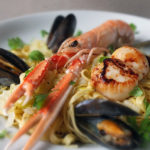Shetland Seafood Linguine Recipe
Indulge in the exquisite flavours of this Shetland seafood linguine, featuring succulent Shetland scallops, tender langoustines, and plump Shetland mussels. A touch of dulse seaweed flakes transforms ordinary pasta into the perfect accompaniment for fresh Shetland seafood.
Servings: 4 people
Ingredients
- 4 tbsps butter
- 1 leek
- 1 onion
- 1 clove garlic
- 80 ml dry white wine
- 80 ml single cream
- 1 kg Shetland mussels
- 4 langoustines
- 4 large Shetland scallops or 8 small
- 1 pinch saffron
- freshly ground black pepper
- fresh flat-leaf parsley to garnish
- 300 grams dried linguine or make your own seaweed linguine from scratch
to make your own seaweed linguine
- 300 grams Italian '00' pasta flour
- 3 large free-range eggs
- 2 tsp dried dulse flakes
Instructions
- Clean the mussels and discard any that are open or have cracked shells.
- Slice the leeks into thin circles and finely dice the onion and garlic.
- Heat half the butter in a deep, heavy bottomed skillet with a fitted lid and gently sauté the vegetables for 5 minutes, until they begin to soften.
- Meanwhile, bring two pans of water to the boil – one for the pasta and one for the langoustines.
- Heat the other half of the butter in a non-stick frying pan.
- Add the cream, wine and saffron to the vegetable mixture and bring to a simmer.
- Add the mussels to the vegetables, give the pan a good shake and pop the lid on, shaking occasionally, for 5 minutes.
- Meanwhile, cook the pasta according to the packet instructions (or simmer for 2-3 minutes if using fresh) and plunge the langoustines into the boiling water, cooking for 2-3 minutes.
- Sear the scallops on both sides for 2-3 minutes each in the frying pan.
- Drain the pasta and toss gently with the mussels and vegetables, discarding any mussels which are not open. Top with a langoustine, the scallops and sprinkle with parsley. Serve immediately
to make the seaweed linguine
- Place the flour into a medium sized bowl and make a well in the centre.
- Crack the eggs into the hole and, using a fork, work the flour into the egg until it starts to clump together.
- Turn out onto a floured surface and knead for 2 minutes, until it forms a smooth but elastic ball.
- Divide into two disc shapes, wrap in cling film and refrigerate for 60 minutes.
- Run through your pasta machine, starting at the thickest setting (twice) and then working through each thinner setting until you reach the desired thickness. Mine was the second from the last setting.
- Run through the linguine setting on your pasta machine and drape over the back of a wooden chair (or use knitting needles propped up under cookbooks if you don't have dowel rods or a wooden chair) to hold the pasta until it's ready to be cooked.
